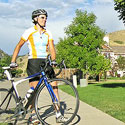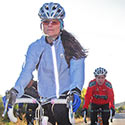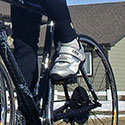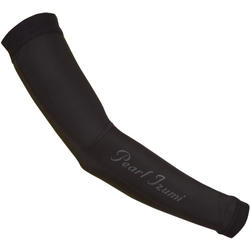Buyer's Guide To Women's Clothing Accessories
Browse Our Cycling Catalog
 While the clothing we discuss here is commonly referred to as women's "accessories," we actually think of these items as essentials. The goal is to be able to dress comfortably for all your cycling and for whatever Mother Nature throws at you. This women's riding apparel makes that possible as you'll see.
While the clothing we discuss here is commonly referred to as women's "accessories," we actually think of these items as essentials. The goal is to be able to dress comfortably for all your cycling and for whatever Mother Nature throws at you. This women's riding apparel makes that possible as you'll see.
Gloves
Bicycle gloves are a must for two types of protection on rides. First, they pad your hands so that the vibrations from the road and trail don't
cause numbness or pain. Plus, should you fall they protect you from
abrasions and cuts. Gloves also wick and breathe so your hands stay dry and
comfortable and don't overheat. Most gloves have terry or
other wicking fabric on the thumbs or backs for wiping your face and
nose.
The most common cycling gloves have half fingers, which helps keep you comfortable and cool and ensures you can grip and operate the brake and shift levers. Glove padding can come in many types and thicknesses so you'll want to try different models on and see what you like. Some cyclists prefer less, some more. It has as much to do with your hands as it does with the way you ride and the feel of the handlebars, tape or grips on them.
You'll also find anatomical cuts, synthetic fabrics, even gel padding on some models. And, there are simple slip-on wrists and gloves with Velcro closures. Again, trying on different types is the best way to choose a pair you like.
 For colder weather there are full-finger models in lightweight
fabrics for basic wind and water resistance, to heavier gloves and mitts
that can handle anything.
For colder weather there are full-finger models in lightweight
fabrics for basic wind and water resistance, to heavier gloves and mitts
that can handle anything.
Arm, Leg and Knee Warmers and Coolers
These are like snug sleeves that slip over your arms and legs to turn any short-sleeve top into
a long-sleeve one, or shorts into tights. They keep your arms and legs warm or shield them from the sun. They fold or roll up small making them easy to carry in a jersey pocket or pack so that you have them handy. And, they go on and off easily too so you can quickly adjust to changing weather conditions. Warmers are now available in fun colors and
patterns.
Usually warmers breathe and wick to keep you dry and comfortable. And they often have rubber grippers on the ends to keep them from sliding down when you're cycling. They're made of stretchy fabric for a comfortable fit and feel and so they don't flap in the wind slowing you down. Some models are made of compression fabrics that support your muscles and can boost your energy.
There are even some bolero-style arm warmers for women with skinny arms who might otherwise have a hard time keeping traditional arm warmers up. Arm coolers are specifically made for protection from the sun and heat on hot days. They usually offer a white wicking fabric that's specially treated to lower the temperature of your skin. They also provide UV protection.
Leg and knee warmers are a lot like arm warmers but even more important since your legs work the most when you're riding. By adding a layer you protect your muscles and tendons by keeping them out of the weather and warm. For excellent protection, leg warmers tuck beneath your shorts and go over the socks.
Knee warmers only cover your knees and work great for protecting them when the temperature drops. They're the smallest warmers, which means they're easier to carry along. Note that you can wear warmers under other warm clothes for double the protection. Also, warmers often have reflective details for safety.
 Socks
Socks
Cycling socks are actually different from regular
everyday models. That's because the fit of cycling shoes is snugger
since your foot doesn't need clearance to move around when cycling. So,
your socks mustn't be too thick or they'll make your foot uncomfortable
in the snug cycling shoes.
This is why cycling socks are made of thin, stretchy materials like spandex and CoolMax and thin wools. These fabrics offer a great fit and feel, nice support, and they breathe and wick so you stay dry and comfortable.
Try wool socks for comfort and warmth in all conditions. They even keep you warm if you get caught in a little rain and get your feet wet. Look for reinforced heels and toes for extra durability. Socks come in various heights so you can choose the look and tan line you prefer.
Toe Covers or Booties
Because your toes lead the way and catch the wind and rain, it's nice to have what you need to protect them. Toe covers slip over the front of your shoes to protect just your toes. They're typically made of water- and wind-resistant and insulating fabrics. They don't provide full protection as they're open on one end. In really nasty weather you'll want even more coverage.
That's where booties come in. These usually offer even more weather protection and warmth. They fit snugly so they won't interfere with the chain when pedaling, and they usually have zippers on the back or side for easy on/off. There are fully sealed models and those that have cutouts for the cleats on the bottom of your shoes too. Some booties also have reinforced toes and heels or tabs there for durability and traction when you're walking.
Even heavier toe covers can be tucked into a pocket or pack when you don't need them. Lightweight booties fold/roll up small too. But, the heavier models made of the most weatherproof materials, like fleece and neoprene will fill two pockets if you need to ride without them.
 Eyewear
Eyewear
Cycling eyewear is not just for fashion and UV protection. It also provides glare reduction so you see better and don't get headaches or tire out on rides from eye fatigue. Keeping the wind out of your peepers helps with this too. And cycling eyewear makers try to provide distortion-free lenses, another way they protect your eyes, fight fatigue and ensure you see clearly.
Most importantly, glasses protect your eyes from flying debris and insects too. This might seem a stretch, but trust us, it does happen and you'll be glad your eyes are protected when it does. And note that the polycarbonate lenses in most cycling eyewear are actually stronger than glass lenses, plus lighter so you carry less weight on your face and the glasses aren't prone to slipping forward when you're riding.
There are many styles and types of women's cycling eyewear. Aside from obvious styling and size differences between women's and men's, some women's glasses are designed to sit a little father away from the eyes to prevent the eyelashes from rubbing on the lenses, which is a nice feature for women. Wrap-around styles provide more protection that aviator models. Most eyewear manufacturers provide cycling-specific glasses and models for fashion, style and comfort and protection off the bike too.
Cycling eyewear can come in one tint designed for all-around cycling or with multiple lenses you change out to suit the conditions. There are also models that offer optional lenses you purchase as needed. Another type is photochromatic lenses that change shade as the light changes. Without changing the lenses you get the protection and vision you need for changing conditions.
 Another nice modern convenience is that more and more makers are offering prescription-compatible eyewear so you can have it custom built just for you and maintain perfect vision on rides. And, eyewear is also easy to match to your helmet, bicycle, clothes — whatever, which is fun too!
Another nice modern convenience is that more and more makers are offering prescription-compatible eyewear so you can have it custom built just for you and maintain perfect vision on rides. And, eyewear is also easy to match to your helmet, bicycle, clothes — whatever, which is fun too!
That's an overview of popular women's cycling clothing accessories. We hope you find it helpful and we look forward to seeing you in the store and showing you our fine selection. Thanks for reading!

